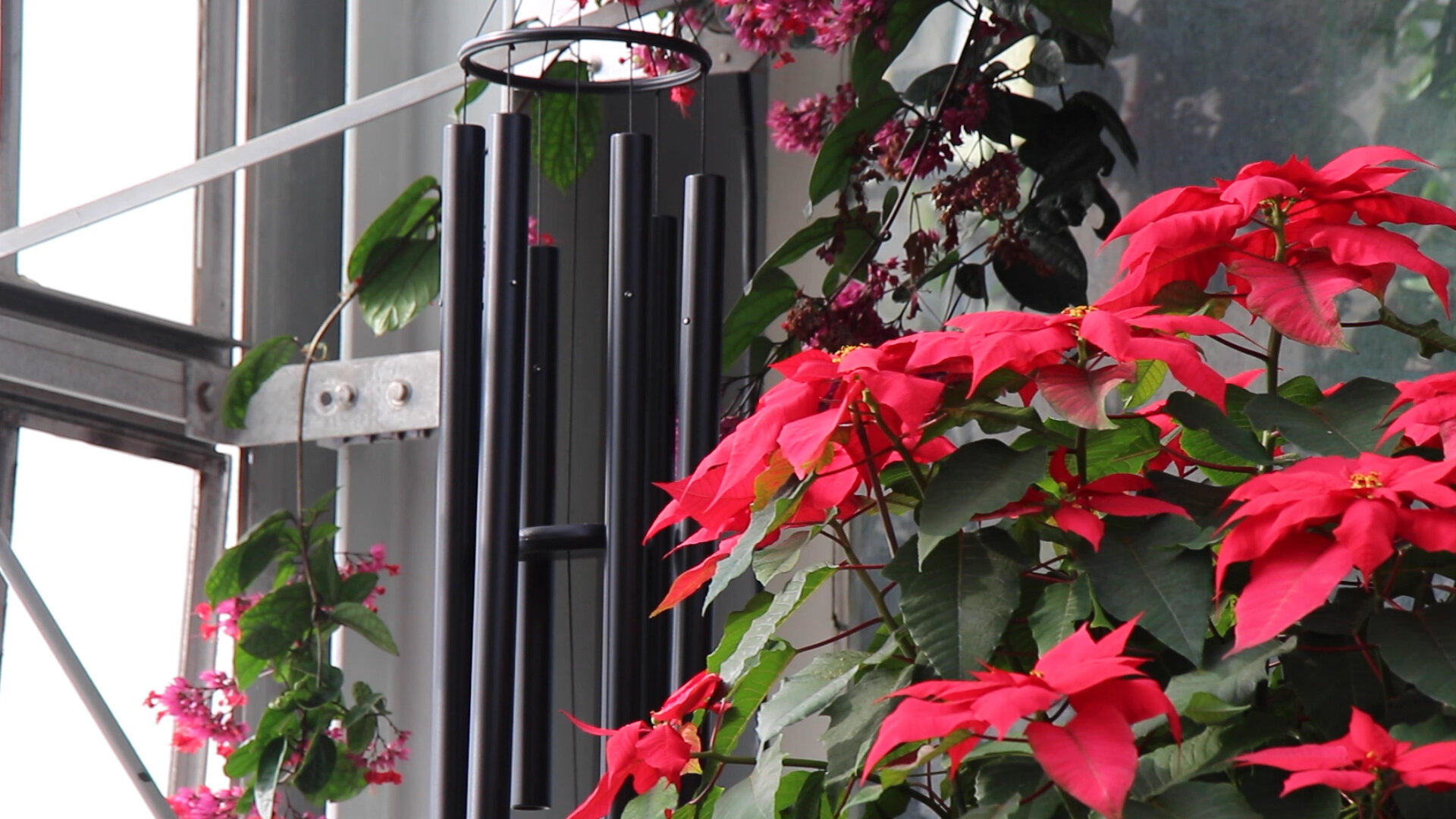Garfield Park Conservatory explores nature’s unseen connections in new holiday flower show
If you’re on the West Side of the city anytime during this year’s holiday season, the Garfield Park Conservatory may be a good place to go to see the visual motifs of the holiday season expressed in a new and interesting way.
Open until Jan. 5, 2020, the Garfield Park Conservatory’s holiday show, “Invisible Forces,” is showcasing different types of plantlife, including multiple varieties of poinsettias, balsam fir trees, coleus, eucalyptus and more, all chosen to immerse visitors in a truly unique holiday experience. Varying shades of red, pink, white, green, gold and everything in between are lining the exhibit hall of the Conservatory while fans blow, chimes sound and energy flows underground. From the first step through the doors, the smell of pine trees hits you and you know that this will be different from most wintertime experiences with nature at the forefront, when plants in the city are usually dying or already dead. But, as holiday show curator Matthew Barrett says, there’s dozens of forces happening underground each second that make the holiday show possible and most of it is thanks to the plants themselves.
This greenhouse at the conservatory is home to the poinsettias used in the flower show. The flowers grow here before being harvested for the show near the end of the year. Photo by Carolyn Chen.
“The idea behind Invisible Forces is to kind of highlight the things that affect both people and plants that you don’t see and maybe don’t think about that often. So sound, wind and, I mean, you can sense the light but really what are the light waves doing; the communication that plants underground through roots,” said Barrett, who also serves as the Deputy Director for Conservatories of the Chicago Park District.
With this year’s theme being the “Invisible Forces,” a lot of thought was put into how best to use the plants and supporting elements to reflect the idea of what you can’t see while still making what you can a uniquely captivating Christmastime experience. All around the room are plants, lights, sounds, vibrations and more working together in a kind of cyclical fashion that’s designed to draw people in and then engage them in the theme on a deeper level. White birch wind chimes whose sound travels through the room in clear, twinkling notes while fans blow them to and fro are just a couple of the details the show’s designers used to help bring the idea to life.
Wind chimes like these in the corners of the exhibit hall work with the white birch wind chimes to bring sound to the flower show and influence the plants in positive ways. Photo by Maia McDonald
“The wind chimes will be blowing and striking and making noise,” Barrett said. “So aside from the fact that wind is what gives them the ability to make sound, the sound itself is something that you hear but can’t see and so we’ve got two different tonal ranges that will be playing throughout the room, throughout the display for people to hear.”
Barrett hopes that those who come to see the holiday show are able to make the connections between the plants, people themselves and how things like sound, vibrations and light can have an immense impact on living things ability to grow.
“We know people are going to come see the holiday display and we just want to open up their minds a little bit to the different things that happen with plants and science and so this is our opportunity to do that,” Barrett said. “So, maybe when they hear a wind chime, you know, there’ll be that cognizant [recognition] of ‘oh, I hear it but I don’t see it’ and what kind of affect that has on plants.”
With so many elements to keep track of for the show to get started on time, Barrett and his team use a step by step process that they follow once all of the plants they need are fully grown and ready to be put in the actual space. It starts, if you hadn’t already guessed it, with the balsam fir trees which are placed first so there’s open areas to work in.
“So, just a couple of days ago none of these plants, the lower plants, were in here,” Barrett said. “We put all the trees in and you start kind of big at the top and then you work your way down. And then we start doing the surrounding supplemental plants with some of the poinsettias, the larger poinsettias, and supplemental contrast plants.”
Any lighting needed for the show, including the lights that hang on the trees is done before the supplemental plants are placed. This is so there’s room for workers to move around the bigger trees and poinsettias. After that smaller plants and other last-minute details can be added in for the show to come together.
“So, we’re trying to keep really strong lines, sweeps of colors, really sculpted patterns,” said Jason Toth, a floriculturist who’s worked at the conservatory since 2014. “There’s also a lot of silver plants that are in the side beds, eucalyptus and different kinds of salvia, things that have a real, sensorial quality. They either smell or feel really interesting. We always try to keep things a little more interactive. We’re kind of stepping away from the classic holly, deep green color and using bolder, wilder colors.”
Red poinsettias like these are a staple of the Garfield Park Conservatory's flower show each year. Photo by Carolyn Chen.
For each year’s holiday show, Barrett works with a team of floriculturists and volunteers to help bring it to life. Poinsettia varieties are ordered around the beginning of spring, near the end of February, and come to the conservatory in June as small seedlings. While the poinsettias grow, the team works together to decide on a theme and choose which supplemental elements are best to help execute that idea.
Figuring out exactly how each element will actually function in the exhibit space, and how long it will take to implement, is also a part of this process. Toth worked closely with volunteers during this year’s show, an effort he says just couldn’t have gotten done without the help of everyday people coming in to help out.
“We run a volunteer army,” Toth said. “Without volunteers, we wouldn’t be able to do any of this. We have hundreds of volunteers that come in on a three-hour basis twice a month. It’s a very minimal commitment but we wouldn’t survive without them.”
A Garfield Park Conservatory volunteer plants red poinsettias a couple of days before the start of the “Invisible Forces” flower show’s start. Photo by Maia McDonald
Hundreds of volunteers help conservatory floriculturists like Toth throughout the year. They plant the flowers, install the larger trees and signage as well as perform other tasks like watering and pruning. Barrett believes the impact of the volunteer work they receive are far reaching. In addition to assisting with the actual construction of the show, they also are able to provide their own ideas on what the show should actually look like, what plants should go where and what would an average viewer of the show best respond to.
“We also like to leave a decent amount of freedom for people to come up with their own ideas as far as the design of the beds or how certain plants should be laid out,” Barrett said. “So it’s not just a piece of paper with a design on it and you have to stick to it ‘cause some of the best designs come out of being given the freedom to play around with things and see what works and what doesn’t work and that usually leads to a really great display that the public loves.”
And Barrett is familiar with what makes people happy around Christmastime. As someone who previously worked in a garden center that sold Christmas trees, Barrett knows what it’s like to be directly involved in making someone’s holiday’s magical. And connecting people to nature during the wintertime is still something he still gets to do, just at the Garfield Park Conservatory with the holiday show.
“That was the best season because everyone was coming in and they were excited.” Barrett said. “They’re picking out their tree. They get home to decorate it and so this is kind of an extension of that. They’re coming here for a reason. So whether it’s they’ve been out looking at the windows on State Street or going up the Mag Mile and looking at the lights or going to Millenium Park to look at ‘The Bean’, we’ve kind of become a stop on everyone’s holiday tour and it’s really fun. And one of the things we like to do is basically bring joy into people’s lives and that’s a really neat thing to do. We try to create places of joy and happiness and I think everyone here does a really great job of that.”





